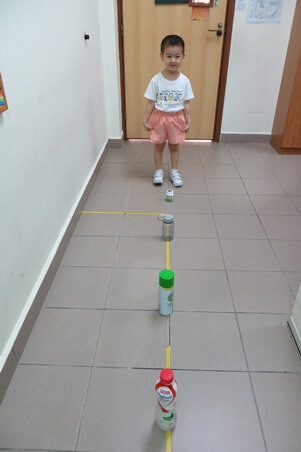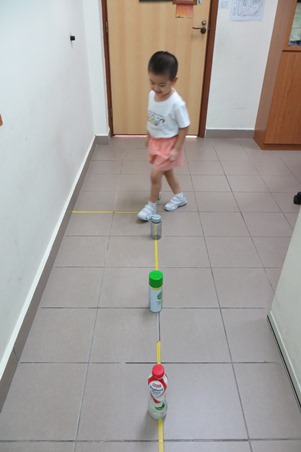Ten Ways to Make your Own Obstacle Course

Obstacle courses are pure fun for small children. Not only do these give children a great way to burn off excess energy, they can help to develop key physical and motor skills in the little ones.
"Many locomotor skills are used on a daily basis, such as leaping over a drain or running to catch a butterfly. In order to master these different locomotor skills, a child requires instructions at an early age as well as ample opportunities to practice them," advises Mrs Elsie Tan-Chua, Principal at Living Sanctuary Kindergarten.
Here are 10 ideas that can easily be implemented both indoors and outdoors, using a few simple household items.
PICK UP YOUR FEET
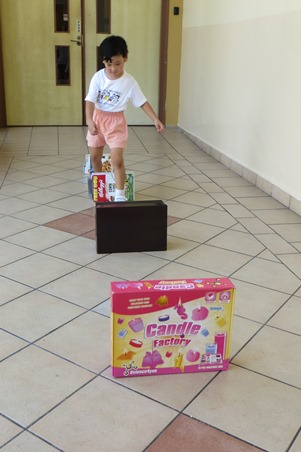 | 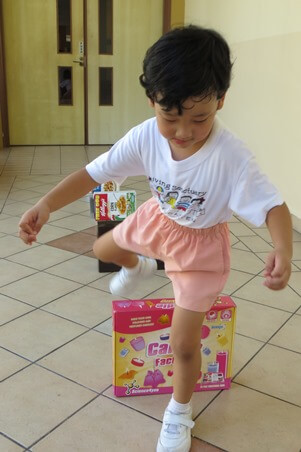 |
Build a walking obstacle course of increasing height - this teaches your child to navigate bigger and bigger obstacles. Use boxes, paper bags or water bottles of different heights, and encourage your child to try stepping over each one. The child practises balancing skills using his whole body as he steps across over each obstacle.
LEARN TO JUMP
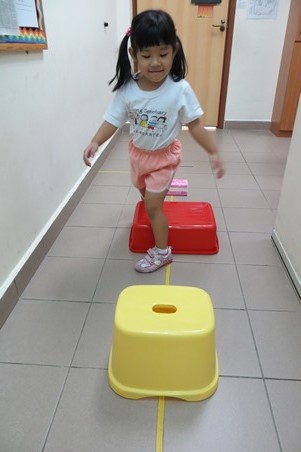
Use soft items such as cushions, pillows and bolsters to create a course of obstacles to jump over. Arrange the items in order of increasing width, to create wider and wider gaps for the child to clear. The child improves his lower body strength as he jumps over increasing distance.
ZIGZAG MOVEMENT
|
|
Use bottles of different shapes and colours (plastic, not glass) to create a zigzag-shaped obstacle course for your child to navigate around. Ask him to try walking the course, then running. Throw a neighbourhood part and have a race! Or make the course more challenging by having your child drag a toy wagon filled with blocks behind him - and to try not to spill any of the blocks! The zigzag movement allows your child to practise reacting in time to change his direction of movement. Adding in challenges along the way helps him to build better concentartion and coordination.
BALLOON TABLE
This is a fun one that works indoors - making it great for a rainy day. Have your child help to blow up balloons, and affix them to the underside of a kitchen/dining table, creating a balloon tunnel to crawl through. Don't forget to wrap the table legs with towels or padding to minimise bumps to the head! Navigating through obstacles on all fours allows him to practise coordination skills. He can make observations of his environment from a different eye-level point.
PLAY HOPSCOTCH
This is an oldie but goodie. Using sidewalk chalk, draw a hopscotch grid along your flat corridor or home driveway. Each player throws a small stone on the first square, then hops the squares in order, before turning and hopping back. If the player completes the course without mistakes, then he can progress to throwing his stone onto the next square in the sequence. If a player falls or misses his throw, his turn ends and the next player gets to try.
TAKE A PAPER WALK
All you need for this are three sheets of A4 paper (or any kind of paper). Imagine that the floor is actually a big river. Your child needs to use the paper as stepping stones to get from one spot in the house to another (e.g. from the bedroom to the living room). This is a great course for challenging your child's problem solving skills, while simultaneously honing his coordination and strength.
ALL TANGLED UP
This works best in a void deck with lots of pillars, or in a garden with many trees. Use brightly coloured string or raffia to create plenty of obstacles for your child to climb over, or crawl under. For an added challenge, tie small numbered/ alphabet tags to the strings, and get your child to collect the tags in order, or collect the correct letters to spell a word. Children who are kinaesthetic learners can pick up and better recall information through an activity like this.
BASKET TOSS

Fill small Ziploc bags with dried rice or beans to create beanbags for a tossing game. Set up various laundry or household baskets to create an assortment of targets. Assign points for landing a shot in each basket, and let your child earn a treat for hitting a high score! This is a fantastic way to help a child develop good hand-eye coordination.
PLAY NEWSPAPER CROQUET
Tightly roll up several sheets of newspaper to create a sturdy tube, and secure with masking tape - this is now your child's "croquet mallet". Mark "holes" in the ground with small pieces of paper or paper plates. Encourage your child to hit a ball into the hole. Or encourage your child to hit the ball at a certain tree/pillar. Set up a course of several targets, and reward your child for completing the round! This requires your child to practise eye-hand coordination in his attempt to take aim.
RECYCLED TUNNEL
The next time you have a delivery of a large household item, save the cardboard boxes to create a series of cardboard tunnels. Encourage your child to crawl through the tunnel - for a younger child you might want to start with a shorter tunnel as a longer one might be intimidating.
As you design the course, do not forget to keep in mind your child's own physical abilities. You want to make the course challenging but not impossible. Set up for success!
No matter which course you decide to try, do not forget to turn on the music, ensure that your child wear comfortable clothes, and most of all, have fun with him!
You may also like

From Cabin to Classroom: Journey of an Outstanding Early Childhood Educator
The PDP modules allowed me to get creative with lesson ideas and keep up with the ever-changing Early Childhood sector.

Ms Farhana Binte Mohamed Hassan
Early Years Educator - PCF Sparkletots @ Pioneer Block 987D (CC)

More Than Just a Place for Food
Young children are highly inquisitive, and learn most effectively with activities that allow exploration and experimentation.

Kinderland @ Yio Chu Kang

Little Fingers Create Great Art - A Community Project by Kinderland and Skool4kidz
I believe this collaborative effort is a very meaningful contribution to the SG50 celebrations.

Kinderland and Skool4Kidz
